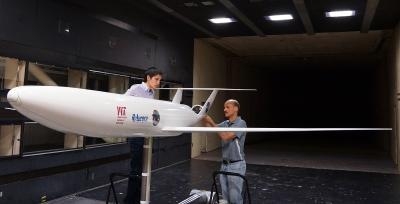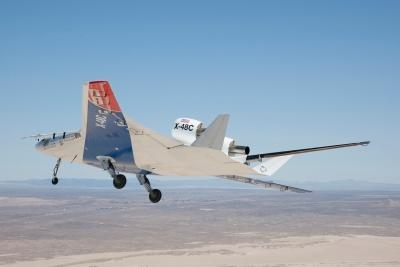Focusing On The Future Was The Dominant Theme Of A Busy Year For NASA's Aeronautical Innovators During 2013
We’ll have a recap of the year in several categories, including aerospace, after January 1. But NASA has already listed what the agency thinks are its major accomplishments for 2013. They include a new “strategic vision” that will guide the agency's aviation research efforts now and into the future which was adopted even as world class research continued at NASA centers across the nation to make air travel ever more efficient and environmentally friendly. "This has been a truly incredible year for us as our entire team continued making exciting technical advances that show great promise for positively impacting our nation’s economy and job growth," said Jaiwon Shin, NASA's associate administrator for aeronautics. "The future of aviation in this country is going to be even more remarkable thanks to the plans made and work we accomplished during 2013," Shin said.

During the year, NASA Aeronautics chartered a new strategic vision for its aviation research programs. The updated vision is designed to ensure that, through NASA's aeronautics research, the United States will maintain its leadership in the sky, and sustain aviation so that it remains a key economic driver and cultural touchstone for the nation. What this means for the flying public is that NASA's contributions to aviation will be even more relevant as ongoing research leads to new aircraft, improved mobility and safety, less impact on the environment, and an all-around better experience in the sky.
NASA is working with the FAA and others to modernize the nation's air traffic control system with the help of new technology, software and procedures – an effort known as NextGen. The technology behind one such tool, which was transferred to the FAA during 2013, is intended to help controllers determine the best time to release an airliner from its gate so it can taxi, takeoff and join a specific slot in the traffic flow overhead.
Known as the Precision Departure Release Capability, it is intended to work with other traffic management tools and will help controllers react more quickly when conditions change because of weather or other problems.
As NASA continues to develop supersonic aircraft that produce quieter sonic booms, researchers have been seeking public input to determine at what point noise from those low booms no longer would be considered a nuisance. During 2013, NASA researchers invited people from a community in Virginia to sit inside a specially constructed "living room" and listen to boom and rattle sounds similar to those caused by a plane flying at supersonic speeds. Researchers sat in a control room and watched as test subjects used computers to record how annoying they perceived the different levels of noise to be. The tests went well and additional tests are planned so more data can be gathered.

The agency also successfully completed a series of tests of a Hybrid Wing Body (HWB) aircraft configuration designed to demonstrate how much quieter the "blended wing" shape could be over conventional tube-and-wing aircraft flown today. The tests, done at NASA Langley Research Center's 14- x 22-Foot Subsonic Wind Tunnel, investigated the combined airframe and jet engine noise using a 1/17th scale HWB model equipped with a compact jet engine noise simulator. The wind tunnel tests also characterized the ability of the HWB airframe to "shield" emitted noise from the engines, which are mounted on top of the airplane. Results indicated that the HWB configuration will meet the project goals of reducing perceived noise 36 decibels below the FAA noise standard, making life around airports a lot more quiet.
In partnership with The Boeing Company and the Air Force Research Laboratory, NASA wrapped up a six-year study of the structural, aerodynamic and operational advantages of the Hybrid Wing Body concept, a cross between a conventional plane and a flying wing design. The manta ray-shaped X-48 Hybrid Wing Body technology demonstrator flew a total of 122 flights, 30 of them as the C-model, at NASA's Dryden Flight Research Center at Edwards Air Force Base, Calif. The last flight of the X-48C occurred on April 9, 2013, having first flown eight months earlier on Aug. 7, 2012.
The X-48 flight tests accomplished the team's goal of creating a ground to flight database to capture data in real time, and proved that the vehicle could be controlled at low speeds as it was put through its paces. The hybrid wing body shape has shown promise for meeting all of NASA’s environmental goals for future aircraft designs in terms of reduced fuel use, emissions and noise.

NASA researchers during 2013 calibrated and validated a computational tool used to assess the risk of engine ice crystal icing, an unusual phenomenon where certain atmospheric conditions allow ice to build up inside a superhot jet engine, sometimes leading to power loss. Inside a test cell at NASA's Glenn Research Center Propulsion Systems Laboratory, now modified to replicate the icing, a full-sized jet engine known to be susceptible was used to test if the new tool would accurately predict the conditions. NASA anticipates the tool eventually will be used by manufacturers when designing new jet engines to reduce the impact of ice crystal icing, if and when it forms.
Everyone agrees that the best solution is to know about problems long before they become problems. During 2013, NASA completed a multi-year study that proved it is technically possible to develop a system inside an aircraft that "reasons" its way to predicting potential trouble onboard before anything happens. NASA and its partners tested the reasoning system using existing aircraft hardware, software, and communication protocols. During testing they accurately predicted a number of faults that were intentionally introduced.
Information from such a system would allow pilots or maintenance personnel to take steps to ensure continued safe operation before any serious problems develop. NASA researchers are working with industry and university partners to develop ideas for future airplanes that dramatically reduce noise, emissions and fuel consumption. A 1/11th scaled model of one such idea was tested in the 14- by 22-Foot Subsonic Wind Tunnel at NASA's Langley Research Center during 2013.
The idea for a future aircraft was designed and built by a research team led by the Massachusetts Institute of Technology. It is called the D8 "Double Bubble" because of its unique shape in which two fuselages are joined together lengthwise. The test was designed to produce data, now being analyzed, that can determine whether incorporating jet engines into the fuselage, either embedded or on pods at the tail end of the airplane, actually reduces drag as expected. More tests are planned for 2014.
Following a series of ground tests completed in 2010 and 2012, NASA began a series of flight tests in 2013 to study emissions from new blends of aviation gas that includes biofuel from renewable sources. NASA researchers are investigating the effect that a 50-50 blend of alternate biofuel has on jet engine performance, emissions and aircraft-generated contrails at altitude. The research involved flying NASA's DC-8 as high as 40,000 feet while an instrumented NASA Falcon HU-25 aircraft trailed behind at distances ranging from 300 feet to more than 10 miles. Preliminary results indicate that the bio fuel blends tested may substantially reduce the emission of black carbon, sulfates and organics. Future research will further study the impact that using bio fuel blends has on the formation of aircraft contrails. A second phase of ACCESS flights is planned for 2014.
(Images provided by NASA)
 ANN's Daily Aero-Linx (04.15.24)
ANN's Daily Aero-Linx (04.15.24) Classic Aero-TV: 'No Other Options' -- The Israeli Air Force's Danny Shapira
Classic Aero-TV: 'No Other Options' -- The Israeli Air Force's Danny Shapira Aero-News: Quote of the Day (04.15.24)
Aero-News: Quote of the Day (04.15.24) Airborne 04.16.24: RV Update, Affordable Flying Expo, Diamond Lil
Airborne 04.16.24: RV Update, Affordable Flying Expo, Diamond Lil ANN's Daily Aero-Term (04.16.24): Chart Supplement US
ANN's Daily Aero-Term (04.16.24): Chart Supplement US





